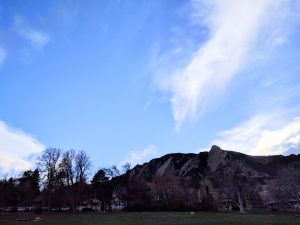 Where There Be Dragons can be considered the Gold Standard of experiential education. I travelled with three other colleagues to their “Rocky Mountain Seminar” to learn more about how we might begin to lean into risk and how we might deepen our ability to learn service before giving service. Nestled into the foothills of Boulder Colorado, it was an ideal location to rethink the paradigms of our programming.
Where There Be Dragons can be considered the Gold Standard of experiential education. I travelled with three other colleagues to their “Rocky Mountain Seminar” to learn more about how we might begin to lean into risk and how we might deepen our ability to learn service before giving service. Nestled into the foothills of Boulder Colorado, it was an ideal location to rethink the paradigms of our programming.
Over the course of four days, I met some incredible people working in incredible schools across the United States. We were brought together by the growing importance of educating global citizens, by the knowledge that we can do more in this area, and that there is still so much to learn about this aspect of education.
Going to the RMS allowed me to put a critical lens on the protocols and processes for international excursions; and it gave me the necessary language to reinforce our approach to community involvement.
My big take-aways from the weekend – and there are too many to account for here – are disruptive in that they ask us to reimagine our students’ experiences and learning by investing more in the how we get our students to that learning.
(1) Lean into risk.
If experience teaches, then embedding a high perceived risk with low actual risk into excursions is a huge lever that we can press for our students. At WTBD, we

discussed the role that risk plays in allowing our students to be reintroduced to their own selves through discovery. Through carefully curated experiential learning, our students can feel they cross over
when on the brink of discovering what they are capable of. In their experience, they are taking a high actual risk, while simultaneously, the instructors, mentors and chaperones on that same experience know that the actual risk is miniscule.
Program leaders should never feel that they are experiencing risk, but our students should perceive that they are…
(2) Practice with the Risk Team.
As with any excellent programming, there is a system and structure in place. When we are teaching a lesson and something goes wrong in the classroom, there are protocols to follow and people in place. We practice fire drills and hold & secure drills so we know what to expect and how to behave effectively to reduce harm and injury both during and afterwards. The same must be in place for international excursions: know who is on your team, and practice scenarios. In this way, the team is less emotional and reactive should a crisis occur. This was underscored by reviewing case studies and lived experiences at WTBDs, and it was so valuable.
Having a team practice their protocols and systems allows you to focus on caring for the students should something go wrong. In the end, it is the students that are the number one concern.
(3) Rethink Service-Learning as “Learning Service”
During the four days many of us shared our programming and the inspiration and goals that underpin those programs. We were given opportunities to examine our own programming with a critical eye, and tackle the question “How might we rethink how our students learn service so that they do no harm.”
We read several articles, one that struck a chord with me was “To Hell with Good Intentions” Written in the 60s by Ian Illich, as an address to the Conference on InterAmerican Student Projects. He addressed the crowd of upper middle class volunteers to “…challenge [us] to recognize your inability, your powerlessness and your incapacity to do the “good” which you intended to do.”

It was made clear that WTBDs creates programming that impacts students that allow them to, and I am quoting a student directly here, “understand that we aren’t the ones to come over and help them, or build for them. We aren’t the ones to come over there and teach them. In fact, it was I who learned the most” (Alec, Boulder CO, Where There Be Dragons program participant 2016, Myanmar). This is in fact what my school aims to do as well: where the only project that our students go abroad to work on is the project of themselves.
I can’t recommend the Rocky Mountain Seminar enough. It has helped me to think critically about our protocols and processes for excursions; it has helped me build out what experiential learning might be at my school; and, it has helped me gain the language to reinforce the work of community involvement that we want for our students.
I really like this, Garth. It is often the final impression of a “service project” experience and it could be helpful to frontload it as a more accurate expectation.
At the same time, maybe it is exactly the opportunity we want our girls to have – the lesson to be learned through solid reflection and understood ‘experientially’?
I love the idea of learning Service.
@gnichols Looking forward to hearing more about this.
Thanks for this article, Garth. I really appreciate the line referring to our students working on the “project of themselves.” I think this is even true for those of us who are guiding these types of programs and even applies for how I feel about my Peace Corps experience in Senegal. My biggest cross-cultural “project” has been the project of opening my eyes, heart, and mind to the people of the world.